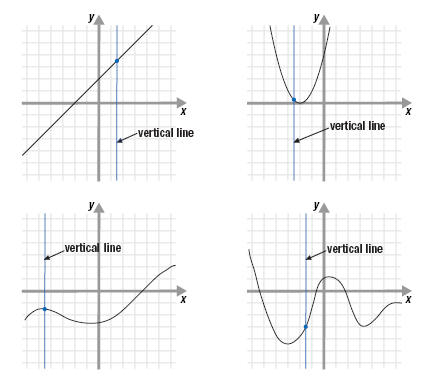Another major concept I understood was the rules of exponents and logarithms for example in logs- log (XY)=log (X) + log (y) , log (X^5)=5log(x), log (X/Y)=log (X)-log(Y). these rules allow you to write and manipulate logs in many different forms. For example you can manipulate log (10) into log (5)+log (2)=log (5x2)=log (10). These rules are very helpful when trying to find a value in an exponential equation or in a logarithm.
A very important concept that I understood about inverses and functions is that f(f^-1(X))=x and f^-1(f(x))=x. This is very helpful in checking whether or not an inverse function is the inverse of a function. I also understood that a function has to pass the vertical line test which states that if a vertical line was passed through a graphed function it should only intersect the function at one point as seen in the image.
 The domain of a function would be what the possible x-values for x can be when inserting into a function or graphically. The domain will give you a boundary about what the inputs(x) can be. The range of a function is the possible y-values of a function meaning a boundary of what the outputs(y) will be.
The domain of a function would be what the possible x-values for x can be when inserting into a function or graphically. The domain will give you a boundary about what the inputs(x) can be. The range of a function is the possible y-values of a function meaning a boundary of what the outputs(y) will be.A function that is one-to-one is any function that passes the horizontal and vertical line test which means it is any function that has an inverse. Passing a horizontal line test on a function is the same thing as passing a vertical line test on its inverse function. Graphically when a function is graphed its inverse will be symmetrical to line y=x.
I had some trouble in trying to figure out an answer to a math problem we got in our homework pg 44 number 35 & 36. I am not really sure whether there are different rules when solving an exponential function that has addition on it.
Rocio and Jesus helped me with #35, which is similar to 36 as well.
ReplyDeleteDo the reciprocal of e ^ -x to the original equation given to you.
Then, multiply both sides by e^x in order to get 1/e^x to become "1". Now you should have e^2x+1 = 3e^x.
Next you subtract 3e^x to both sides and get e^2x-3e^x+1= 0.
Now its in the format of a quadratic equation.
You then have to complete the square
Treat e^x as just x
After completing the square you get
3 +/- (square root) 5 / 2.
"After that you take the natural log of everything to cancel out the e and you have your answer"